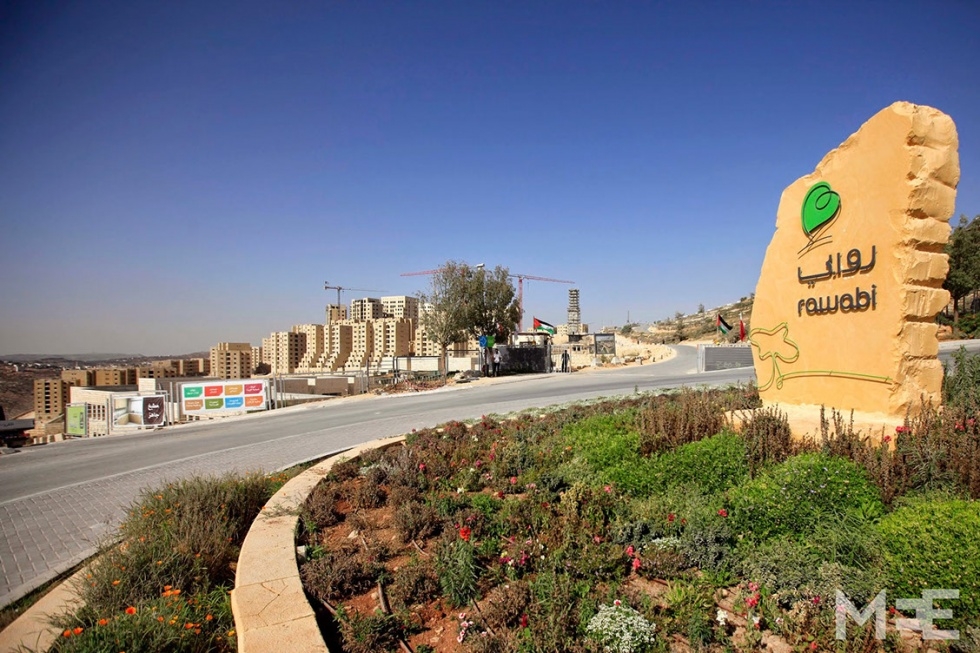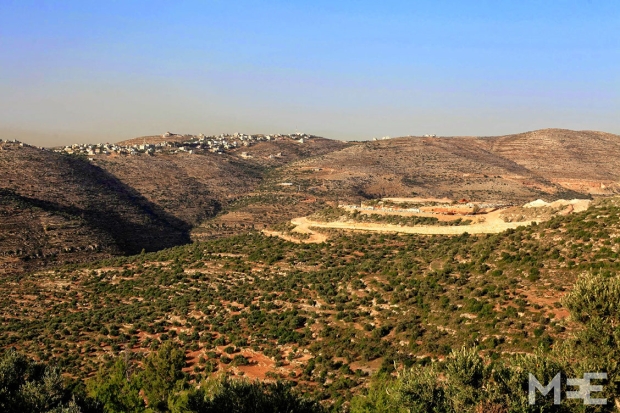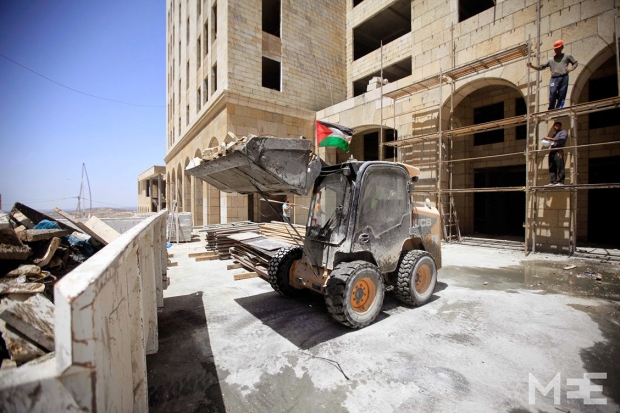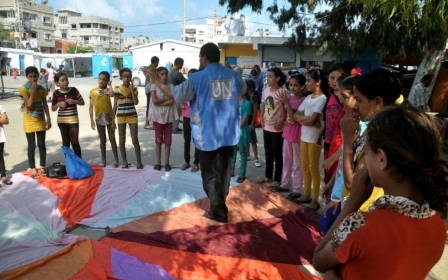Palestine's first planned city causes tensions

The largest stone cutting factory in the West Bank runs 24 hours a day at Rawabi, cranking out building blocks for the first planned city in the Palestinian Territories. The $1 billion development - a tenth of Palestine’s GDP - lies among the bucolic hills a few kilometres north of Ramallah, the commercial hub and administrative capital of the West Bank.
But the Rawabi project has created lingering tension with residents of surrounding villages who say their land was taken for the development against their will and with minimal compensation. Almost 1.8 million square metres of Rawabi’s land – or 1,800 dunams, an Ottoman land unit commonly used in the West Bank - was obtained for the development by the Palestinian Authority (PA) in November 2009 under a 1953 eminent domain law.
Bashar Masri, Rawabi’s chief developer, says that the overwhelming majority of the land taken as eminent domain was already owned by Bayti, the joint Qatari/Palestinian company developing Rawabi. He says that the eminent domain process (istimlak in Arabic) was only used to expedite the title registration for the real estate.
Masri, a billionaire entrepreneur from one of Palestine’s wealthiest families, focuses on the project’s benefits. He points to almost 8,000 jobs created by the development, which is finishing construction on its first two neighbourhoods and hopes to start accepting residents in late 2014 or 2015.
“We are the number one job generator in the nation, private sector,” Masri told MEE. He calls the effect of the project on the growth of the Palestinian economy “massive.”
“It’s upgrading a lot of industries... and the longer the project goes, the more industries will be developed around the project,” he adds.
Ultimately, Rawabi hopes to house some 40,000 residents, easing the 200,000 unit housing deficit projected for the West Bank in 2020.
Apartment prices in Rawabi run from $65,000-$180,000. New mortgage instruments and agreements with local banks are designed to make long term loans for the apartments attainable for middle-class Palestinians, but Masri recognises that the price may not be affordable for poorer Palestinian households.
“Our goal is that the monthly mortgage payment for the owner is $400-$800,” he says. “That is in my opinion affordable range. That’s middle-income; this is not low-income.”
Villagers from Ajjul, a sleepy nearby township whose residents owned more than 1,500 dunams of the lands obtained for Rawabi under the istimlak law, say the development has left the village compressed and residents uncertain where their children will be able to live.
“This project has two sides, an advantaged side and a disadvantaged side,” says one resident of Ajjul who asked to be identified pseudonymously as Sami Ali. “Maybe it will bring benefits to the Palestinian people,” Ali told MEE, “but I think it will also bring many problems for this small village.”
According to Ali, his grandfather owned 70 dunams of land in what is now Rawabi. The land was split between Ali’s father and uncles, some of whom sold the properties before istimlak was invoked, and some of whom had property seized as eminent domain.
Ali says the money his father received as compensation for his land wasn’t enough to offset the damage done by the loss of the property. “My father took money and it’s almost disappeared,” he says, “so what benefit did we get?”
“Where are my sons going to build?” he asks.
Use of the istimlak law requires a public purpose for the confiscated land. But what constitutes public purpose in the law is vague and not subject to review, according to a 2008 legal report prepared for the PA Ministry of Planning by Land Equity International.
“In none of the expropriation legislation is there an opportunity for review of the question of whether the taking of land is for a valid public purpose, or whether the state is taking more land than is needed for the purpose,” reads the report. “If the government decides that the project is in the public interest, then that decision is conclusive of the fact.”
In the case of Rawabi, the public purpose of the development was construed as both its economic benefit and its placement near Ateret settlement in an undeveloped part of Area A, the 17% of the West Bank overseen by the Palestinian Authority government.
“[Rawabi] picked a location where it actually had to challenge the occupation head on from the beginning,” says Sam Bahour, a Palestinian businessman who sits on the general assembly of the Palestine Investment Fund, a major real estate developer and mortgage investor connected to the Rawabi project.
“It wasn’t public use. It was a private, for-profit real estate venture,” says Ali Abunimah, a prominent Palestinian-American journalist and activist who wrote on Rawabi and the use of istimlak in his February 2014 book The Battle for Justice in Palestine.
“But because they frame it as...part of national development and building up the Palestinian state, that’s what allows them to market it as being public use. But there’s nothing public about it,” Abunimah told MEE.
Masri says the employment opportunities created by Rawabi alone are enough of a public benefit to validate the use of istimlak. “It has public benefit - very clear: the employment itself,” Masri told MEE. “If a project is deemed to have public benefit, the developer has the right to request the government... [put] its hand on lands that are absolutely needed by the project.”
Furthermore, he says that 95% of the land which came under the istimlak law was bought by Rawabi from individual landowners prior to the legal order, and that the law was only used to expedite the registration process on the land.
As recently as 2008, only 30% of land in the West Bank was registered due to a history of overlapping and inconsistent land laws and the requirement that all outstanding taxes be paid before registration or legal land sales occur, according to the PA’s National Land Policy Framework.
Abunimah and Ali claim that the government used istimlak at Rawabi’s request to lower the price that Bayti, the development company, would have to pay for the land. In The Battle for Justice in Palestine, Abunimah notes that Bayti offered 35,000 Jordanian dinars (about $50,000) per dunam for the land of the al-Attari family prior to the istimlak order, but lowered the compensation to 5,000 dinars ($7,000) after the law was invoked.
Ali says that his family saw a similar drop in the offered price after istimlak was used. He told MEE that his relatives who sold before the confiscation order were given about 5,000 dinars per dunam, but prices dropped by as much as half after the order.
“They gave high prices to encourage people to sell, but after they got the istimlak, they [lowered the price],” says Ali. He calls istimlak “a very oppressive law.”
Masri disputes Ali and Abunimah’s figures, saying that Bayti bought the land for an average of “more than $50,000” per dunam. He pegs the price for which Bayti is selling the land to Rawabi’s homebuyers at about $100,000 per dunam.
Ali told MEE that the prices Bayti initially offered tempted many people to sell their land, but once Rawabi had started buying the properties and obtained the istimlak order, “the project became unstoppable.”
As to the villagers who sold before the November 2009 istimlak order, opening the door for Bayti to request the expropriation based on Rawabi’s need for the remaining land, Ali says, “they regretted it.”
New MEE newsletter: Jerusalem Dispatch
Sign up to get the latest insights and analysis on Israel-Palestine, alongside Turkey Unpacked and other MEE newsletters
Middle East Eye delivers independent and unrivalled coverage and analysis of the Middle East, North Africa and beyond. To learn more about republishing this content and the associated fees, please fill out this form. More about MEE can be found here.





